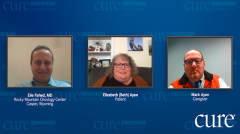
Multiple Myeloma: The Importance of Communication
Elie Fahed, MD, and Beth discuss the importance of communication in the management of multiple myeloma, and Mark shares advice for caregivers regarding communication.
Episodes in this series

Elie Fahed, MD: Beth, how important has communication been for you while on treatment throughout the years?
Elizabeth Ayen: Communication is definitely important. You and I went through this process, at least at the beginning—we were just trying to figure how you and I could communicate well together. We’ve got that down pretty well now after, oh gosh, eight years. At first, I wasn’t sure how to—as Mark had said earlier—how to explain to you the pain I was in and if it was important pain. Is it old pain? Is it new pain? What is this? We’ve had to work through that over the years, as far as communication goes. I know you’re always willing to answer any questions that I have.
Elie Fahed, MD: Continue working on that communication. It’s a two-way street, and it is very important to listen. From a physician standpoint, I think, it is very important to listen. A patient knows their body better than anybody else. When they tell you this pain is new or different, just listen to them. They know what they are talking about, and they know how they feel.
Elizabeth Ayen: Yeah, I would say 80% of the time I was right about something.
Elie Fahed, MD: I admit, whenever you told us there was, or it seemed like we had progression here, we did imaging, and you were absolutely right. You can tell if the pain is new or just a remnant of an old lesion. You are able to guide us. You have one of the hardest myeloma diseases to treat, so we are going to have rely on objective markers or measurements. We really have to rely on symptoms, and you have to guide us on where to image and where to do an MRI. We cannot do a full-body MRI every few months to see what’s happening.
Elizabeth Ayen: Right.
Elie Fahed, MD: Do you have any advice for caregivers, from a patient perspective? I know we had a supportive caregiver in Mark.
Mark Ayen: I am in a couple of caregiver myeloma Facebook groups. I get frustrated with them because, as I said before, every myeloma patient has a totally different deal. Their reactions to some drugs are going to be totally different from someone else’s reactions. The advice I give people is just communicate—talk to your wife, and find out what she needs, how you can help her, and what things you can do to help. Beth and I were talking the other day, because back when we started this, in 1997, the internet was like a baby. We had no resources other than, “Here’s a pamphlet on multiple myeloma.” Today if you say, “Oh, you have multiple myeloma,” you have 57 websites, a bunch of articles, support groups, and all this stuff you can be part of. We did not have any of that for 15 years. We were on our own, and we had to figure it out. We figured it out by talking about what Beth needed. I’d ask, “What is it that I can do? Where does it hurt? Does rubbing this help, or does rubbing not help? Does ice help or does it not help?” Having those conversations and just trying to help wherever you can is important, and that is my advice.
Elie Fahed, MD: It is very important. We are much better connected everywhere. Information flows so much easier in the age of internet, in the age of Facebook. I am glad you have that experience, that connection with other patients across the globe whom you can speak with, even internationally. Also, I really want to stress what you said about every patient’s experience being different. If a certain regimen did not work for a certain patient, that does not mean you should not try it. If a patient had a bad outcome with a certain combination or a certain treatment, it does not mean you should not try it. Every situation is unique. The medication that doesn’t work for you might work beautifully on somebody else. It is important to keep that perspective, and for patients to know that every situation is unique.
This transcript has been edited for clarity.

